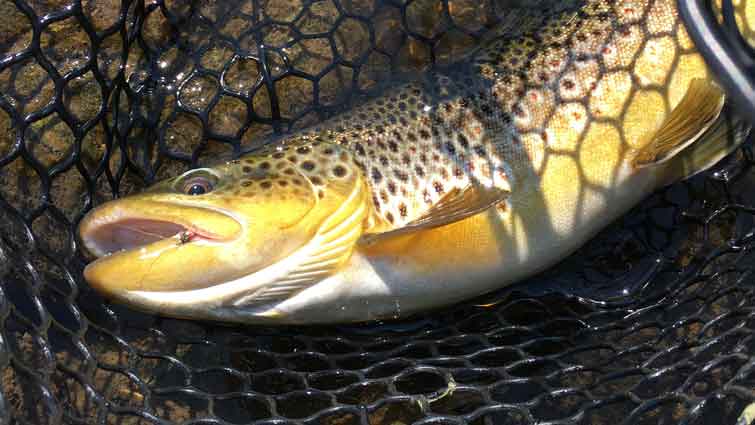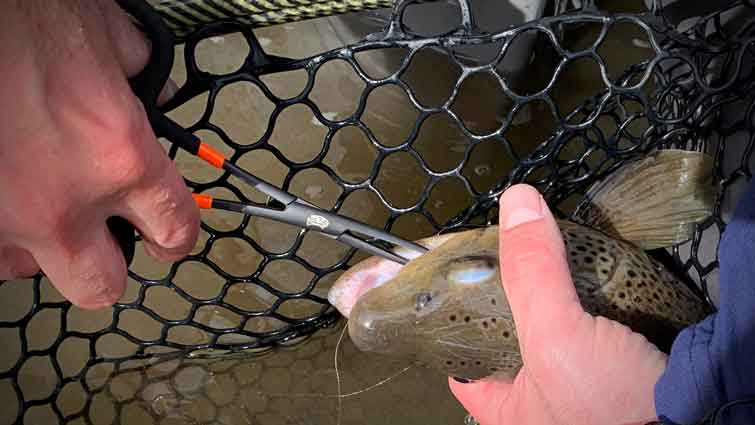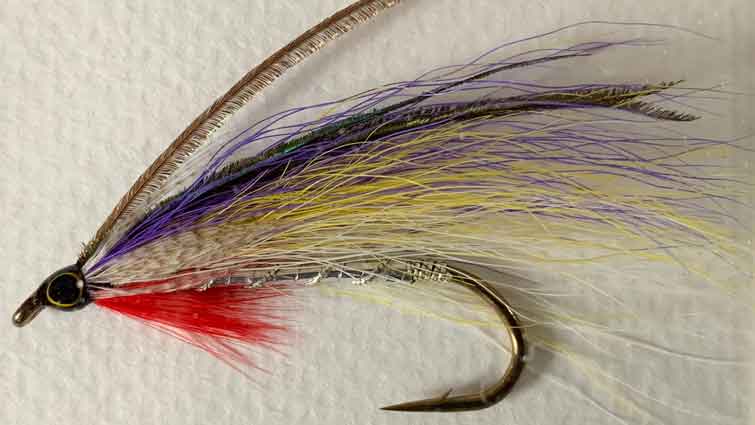Nymphing is a very versatile fly fishing technique that can be done with a variety of different set-ups, so it's essential to tailor your gear selection to the specific conditions you'll be fishing in.
As a general rule you will need this gear for traditional nymphing:
- 3 to 6 weight fly rod
- Floating fly line
- 9ft - 5x fluorocarbon or monofilament leader
- 5x and 6x fluorocarbon or monofilament tippet
- Nymphs
- Net
- Nippers
- Forceps
- Waders and Wading Boots

When choosing a fly rod for nymph fishing, you'll want to consider the weight of the line you'll be using. In this article, we'll take a look at what gear you'll need to get started with traditional nymphing.
What Makes a Nymph Fly Rod?
A nymph fly rod is designed to cast lightweight flies and long leaders effectively. They are generally 3-weight or 4-weight rods and have slow action. They can be used for both trout and bass fishing, making them a versatile option for anglers.

Some characteristics that make an excellent Nymph fly rod include:
- 9 to 11 ft in length
- 3 to 6 weight
- Slow action
- A light, floating line
This will help you cast the nymphs delicately and maintain control over them, especially in windy conditions. Nymphing rods are often longer in length, as they need to reach further when casting.
The Length of The Rod
For nymphing, a rod in the 9 to 11 ft range is ideal. This will give you enough length to control your casts, as well as sufficient power to fight fish. It's important to find a rod with slow action, as it will help you delicately present your nymphs to the fish. A fast action rod will put too much energy into your casts, which can result in your flies landing too hard and spooking the fish.
A longer fly rod allows you to target a more significant amount of water (beneath the rod) with your fishing equipment. You'll be more successful with the extra length covering more water in front of you, and you'll be able to retain better control of your flies.

The Weight of the Rod
Three-weight rods are ideal for nymphing. They are light enough to provide a delicate presentation, but they also have the power to fight larger fish. Heavier rods can also be used for nymphing, if you need more control over larger fish.
When choosing a nymph fly rod, you'll want to consider the weight of the line you'll be using. In general, a 3-weight fly rod is ideal for traditional nymphing techniques. A 3-weight fly rod will easily handle most trout streams, and it can also be used for small bass and panfish.
A good quality reel is essential when fly fishing with nymphs. The drag system on the reel should be able to handle larger fish without slipping, and it should also have a smooth operation. You'll typically need a larger arbor for nymphing, as this will allow for quicker line retrieval.

The Weight of The Line
When choosing a line weight for nymphing, it's important to consider the weight of the fly rod you're using. If you have a three-weight rod, for example, you'll want to match the line weight to your rod. A line that is too heavy for your rod will result in poor casting performance and could damage your equipment.
Lighter, thinner lines are more difficult to cast. Because of this, some casting style changes are needed.

Floating lines help to keep your fly higher in the water column, which is ideal for nymph fishing long distances. In general, you'll want to use a floating line when nymphing with a strike indicator.
Another consideration when choosing a line for nymphing is the length of the line. A longer line will help you cover more water, but it will also be more difficult to control. If you're fishing a smaller stream, it might be best to use a shorter line.
In general, you'll want to use a long line when fishing larger streams and rivers. A longer line will give you more casting distance and allow you to reach more fishable areas.

Slow Action
A slow-action rod is ideal for nymph fishing because it provides more feedback and helps you feel the strikes. When a fish takes your nymph, the rod will bend deeply, providing you with instant feedback. This allows you to set the hook quickly and effectively.
A slow-action rod bends throughout the entire length of the rod, giving you the most flexible action available. Used typically for small fish, such as a panfish, slow-action rods will allow the angler to have a better fight and shock absorption so that hooks don't rip through the mouth.

What Kind of Rod Is Used for Nymphing?
Nymphing is a type of fly fishing where you use a weighted fly and a short leader to fish beneath the surface of the water. The flies are typically fished in calm water, such as ponds, lakes, and slow-moving streams.
For nymphing, you'll typically need a 9 to 11-foot three-weight rod. This will give you the right amount of flex to make gentle presentations to fish hiding beneath the surface.
Your nymphing rod should have a slow action, meaning that it bends easily. This is important because you'll be using light flies, and you don't want the rod to snap the line on contact with a fish.
Additionally, a slow-action rod will help you play fish gently, avoiding unnecessary injuries. Many anglers prefer fiberglass rods for nymphing, as these materials have a slower action than graphite rods.

What Size Reel Should I Use for Nymphing?
The majority of fishermen choose a reel suited to the weight of the line they are utilizing. To minimize the strain on longer rods, use a heavier reel than you would for dry fly fishing.
For nymphing, you'll want a reel that is capable of holding at least 100 yards of a 4-pound test line. Drag-free drifts are required for an effective nymphing system. This entails controlling the nymphs' speed in any sort of water, even in fast or complicated streams.
A 4-weight line is an excellent nymph fishing line size and the choice of many competition anglers. With a four-weight, you can throw heavier rigs than you can with a three-weight without giving up much sensitivity. Four-weights also make great cross-over rods for fishing dry flies and small streamers if that’s your thing.

What Line Do I Use for Nymphing?
When selecting a fly line, it's important to consider the weight of the rod you're using as well as the size of the stream or river you'll be fishing.
For nymphing, you'll need a four-weight line at the very least. A three-weight line can work in some situations, but it's not as versatile as a four-weight. Nymphing with a light line is possible in slower water and allows you to use smaller flies.
In general, the line weight rating of a rod influences four major aspects when fly fishing:
- Casting distance
- The size of the fly you can cast
- The size of the fish you can land
- Overall rod sensitivity
Line weight for nymphing should also be matched to the weight of your fly fishing reel.
Leader length is another consideration when it comes to gear for nymphing. Leader length for nymph fishing should be around 10-12 feet. This gives you enough reach to get your fly into tight spots without having to go too far upstream.

Tippet size should be 4X - 7X for the majority of applications. Depending on water depth and various factors, length can range from 3 to 6 feet or more. For your tippet and leader, you'll want to use a light fluorocarbon or monofilament. The reason for this is that you'll be using smaller nymphs, which means you don't need the weight or abrasion resistance that a heavier tippet would provide. A 6-8lb test should work well for this type of fishing.
There are a few things you'll want to look for in a fly line designed specifically for nymph fishing:
- A floating line
- A weight forward taper
- The ability to easily pick up and carry the slack
These things will help you with delicate presentations and keep a good connection with the fly throughout your casts.

What Types of Flies Do I Use Nymphing?
When it comes to flies, there are endless options to choose from. However, when getting started with nymph fishing, there are a few basic patterns that will serve you well.
Some essential nymphs for trout fishing include:
- The Hare's Ear
- Caddis Larva
- The Copper John
- The San Juan Worm
When selecting flies, it's important to consider the natural food sources of the fish you're targeting. For example, if you're fishing a stream that is home to plenty of aquatic insects, you'll want to use a variety of fly patterns that imitate different stages of an insect's life cycle.
To guarantee they reach the bottom of the stream, most nymphs have a bead head on top. Before a hatch, emerging insects are useful. You'll see fish feeding on emerging insects if you see its tail sticking out of the water.
Nymphs are insects that develop in water as larvae and then transition to land-dwelling adults. A nymph has gills on its belly or false legs at the end of its abdomen, which distinguishes it from an adult. A nymph has no wings because they are so tiny. They have no mouth parts but do have antennae and eyes.
Nymph flies are meant to mimic the immature stage of aquatic insects like:
- Caddisflies
- Stoneflies
- Mayflies, and
- Midges
Ensure you consider the time of year and conditions you're fishing in so you can match the hatch.
How Do I Know What Nymph to Use?
The first thing you need for traditional nymph fly fishing is an assortment of flies. This can be a daunting task, as there are many different types of nymphs and even more imitations. To get started, purchase a variety of nymphs that represent the most common insects in your area. You'll also want to have some terrestrial patterns (flies that imitate insects that live on land) in your arsenal, as trout will often take these when there's no hatch happening. A good starting point is to have flies in sizes 16-12.
Matching the hatch is the surest way to know what type of nymph to use. Matching the hatch refers to choosing a fly that imitates the most common insects in the area at that time. This can be tricky, as it often involves being able to identify the various types of insects in your area and then matching their colors and sizes as closely as possible.

Nymph life cycles can be helpful in choosing the right fly. For example, if you know that the nymphs of a certain species are hatching, you can choose a fly that imitates that particular nymph.
When fly fishing for trout, nymphs are often the most productive flies to use. Nymphs are underwater versions of adult insects, and they represent the majority of the trout's diet. There are many different types of nymphs, and each has its own unique lifecycle. As a result, there is no one "right" fly to use when nymph fishing; instead, you need to match the fly to the particular water conditions and hatches that you are encountering.

Conclusion
When fishing nymphs, you'll need some specialized gear. The most important piece of equipment is a good fly rod. A fast-action rod is ideal for nymphing; it will allow you to make quick casts and detect the subtle strikes of trout. You'll also need a quality fly reel with a capacity of at least 100 yards of backing line.
In addition to a fly rod and reel, you'll need specialized flies, tippet material, and a landing net. You can either buy these items pre-made, or you can make them yourself. If you choose to make your own flies, be sure to purchase the right materials and learn how to tie them correctly.





